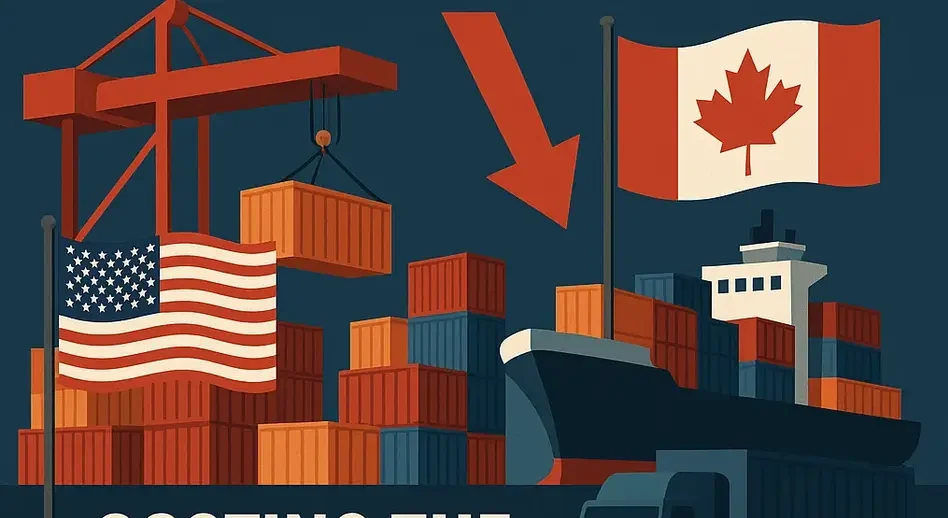The Growing Canadian Boycott of US Products
The relationship between the United States and Canada has historically been one of the strongest trading partnerships in the world. However, recent trade tensions have sparked a significant shift in consumer behavior north of the border. In response to U.S. tariffs and political tensions, approximately 71% of Canadian consumers now report they intend to buy fewer American products this year. This “Buy Canada” movement is having measurable impacts on the U.S. economy, with potential GDP losses of up to 0.3% (approximately $90 billion) in 2025.
According to a recent report by the U.S. Chamber of Commerce, bilateral trade between the U.S. and Canada exceeded $800 billion in 2023, supporting millions of jobs on both sides of the border. The current disruption threatens this deeply integrated economic relationship that has been built over decades.
Canadian Retailers Respond to Consumer Demand
Giancarlo Marchi, owner of Vince’s Market (a Canadian grocery chain with four locations serving about 30,000 customers weekly), has witnessed this consumer shift firsthand. “Our customers are demanding from us as much Canadian product as possible,” Marchi explains. “They’re getting frustrated and upset when they see too much US product.”
The change has been dramatic enough that retailers are actively delisting American versions of products when Canadian alternatives exist. Vince’s Market has even decorated their stores with Canadian flags and labels to highlight domestic goods, while consumers are using apps like Maple Scan to identify product origins.
From Produce Aisles to Wine Shelves: The Widespread Impact
The boycott affects various sectors differently:
- Produce: While traditionally up to 70% of off-season produce came from the U.S., Marchi reports they’re now running at only about 30% American produce
- Packaged Goods: Major brands like Coca-Cola and Frito-Lay have responded by prominently displaying their “Made in Canada” credentials
- Alcohol: The hardest-hit category has seen American wines and spirits virtually disappear from Canadian shelves following a 25% tariff on all U.S. alcohol products
“Our wine business, roughly 35-40% of our red wine sales is California cabs and blends. That’s $60,000 a week in sales that are just gone,” notes Marchi.
Beyond Boycotts: The Tourism Impact of Canadian Tariffs
The economic consequences extend beyond retail goods. International travel to the United States is experiencing a significant downturn, with Canadian visitors—traditionally the largest group of international travelers to the U.S.—leading the decline.
Tourism Numbers in Free Fall
In 2024, 20 million Canadians visited the U.S., generating $20.5 billion in spending. However, recent data shows:
- Online travel searches from Canada to the U.S. dropped 50% this spring
- Canadian drive traffic decreased nearly 30% in March
- Combined air and land travel fell about 15%
- Border communities in states like Michigan and New York are reporting plunging revenues
Hiring? Post Jobs for Free with WhatJobs
Looking to expand your team despite economic uncertainties? WhatJobs offers free job posting services to help you find qualified candidates in today’s challenging market. Whether you’re a Canadian company seeking local talent or an American business expanding northward, WhatJobs connects you with job seekers across North America.
Post Your Job Listing Today →Need Career Advice?
Navigating the job market during trade tensions? Our career experts can help you understand how economic shifts affect employment opportunities on both sides of the border.
Get Personalized Career Guidance →
FAQ: Canadian Tariff Impact on US Economy
How much could the Canadian tariff impact cost the US economy?
The Canadian tariff impact on US economy could result in losses up to 0.3% of GDP, approximately $90 billion in 2025. This significant impact comes from both the boycott of American goods and the substantial decline in Canadian tourism to the United States.
Which US industries are most affected by the Canadian tariff impact?
When examining the Canadian tariff impact on US economy, the alcohol industry has been hit hardest, with American wines and spirits facing a 25% tariff. In 2024, Canada was the US’s top export market for alcohol, importing $435 million in wine, $221 million in spirits, and $41 million in beer.
How are American brands responding to the Canadian tariff impact?
In response to the Canadian tariff impact on US economy, companies like Coca-Cola and Frito-Lay are emphasizing their Canadian manufacturing facilities by adding prominent “Made in Canada” labels to their products.




